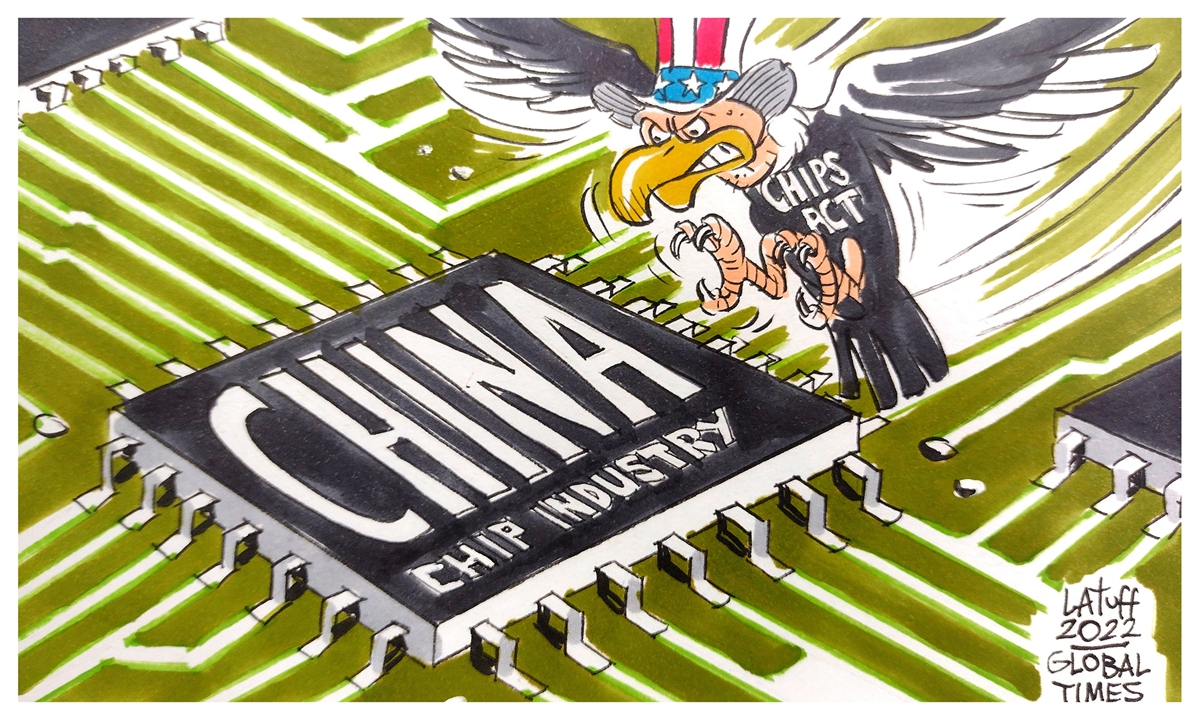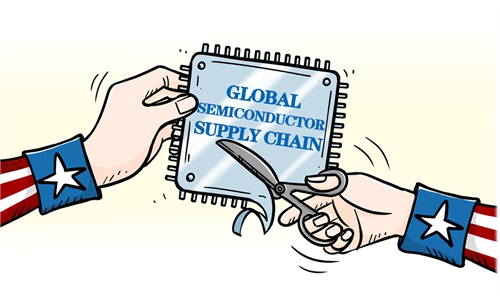
US claws at China's chip industry fanning flames on tech confrontation. Cartoon: Carlos Latuff
Despite the considerable challenges posed by intense pressure from the US on China's semiconductor sector, the resilience and progress demonstrated by China in this industry underscore its unwavering determination to overcome external obstacles and pursue independent innovation. This commitment also injects new vitality into the diversification and sustainable development of the global semiconductor landscape.The Korea Chamber of Commerce and Industry's (KCCI) Sustainable Growth Initiative stated in a report that China continues to function as a hub for global semiconductor manufacturing supply chains, noting that the trade interdependence among semiconductor powerhouses, excluding the US, remains high, making it difficult to quickly restructure supply chains centered around the US and its allies, the Yonhap News Agency reported on Tuesday.
The report highlights the deep interconnection and cooperation in the global semiconductor sector, as well as the role China plays in the global supply chains. It comes against the backdrop of the US consistently imposing increasingly stringent policies to prevent China from obtaining advanced chips.
For instance, a recent Bloomberg report said that US government officials are reviewing its artificial intelligence (AI) chip policy and discussing a new approach to regulating sensitive technology by setting a ceiling on export licenses to certain countries for fear they could be diverted to China.
The reason why the US is reportedly considering new restrictions, particularly the export limitations on AI chips, is because the initial US move to curb China's technological development did not yield the expected results. This shift toward more aggressive measures aimed at strengthening the containment of China highlights the complexities and challenges the US faces in restructuring the global semiconductor sector. While some US policymakers initially believed that targeted actions in key areas could swiftly reshape the semiconductor market landscape, reality has shown that the difficulties of restructuring the global supply chain far exceeded their expectations.
On the one hand, the global semiconductor supply chain is intricately interconnected, meaning that any unilateral action by one party can trigger a chain reaction, affecting the stability and growth of the entire industry. On the other hand, China's independent research and development (R&D) efforts in the sector are making rapid advances. The restrictions imposed by the US have actually spurred China's innovative capabilities and industrial resilience, prompting the country to accelerate the establishment of a self-sufficient semiconductor industry system.
While the development path of China's semiconductor sector is fraught with US pressure, its pace of breaking bottlenecks never stops. In recent years, China has made significant breakthroughs in the semiconductor field. These accomplishments have not only established a solid foundation for the self-sufficient development of China's semiconductor sector but also provided strong support for overcoming US constraints.
More importantly, the Chinese semiconductor sector has fully recognized the importance of establishing a self-sufficient, secure and reliable supply chain, which is essential for future growth. This necessitates a commitment to enhancing independent R&D, as well as core technological capabilities, while also actively pursuing international cooperation to create a global framework that leverages complementary advantages and resource sharing.
Despite attempts by the US to dominate the high-tech sector through hegemonic means, the trend of globalization in the semiconductor sector is undeniable, and collaboration among nations will persist. China should capitalize on this momentum by fostering dialogue and cooperation with countries worldwide in the semiconductor arena, thereby promoting the healthy development of the global semiconductor sector.
Of course, it must be acknowledged that the path for China's semiconductor sector remains challenging and is full of twists and turns. The containment policies imposed by the US are unlikely to be easily lifted, and the international competitive landscape will continue to grow more complex and become more unpredictable. Therefore, it is essential to maintain strategic resolve and consistently strengthen China's position and influence in the global semiconductor supply chain through measures such as enhancing independent R&D.



